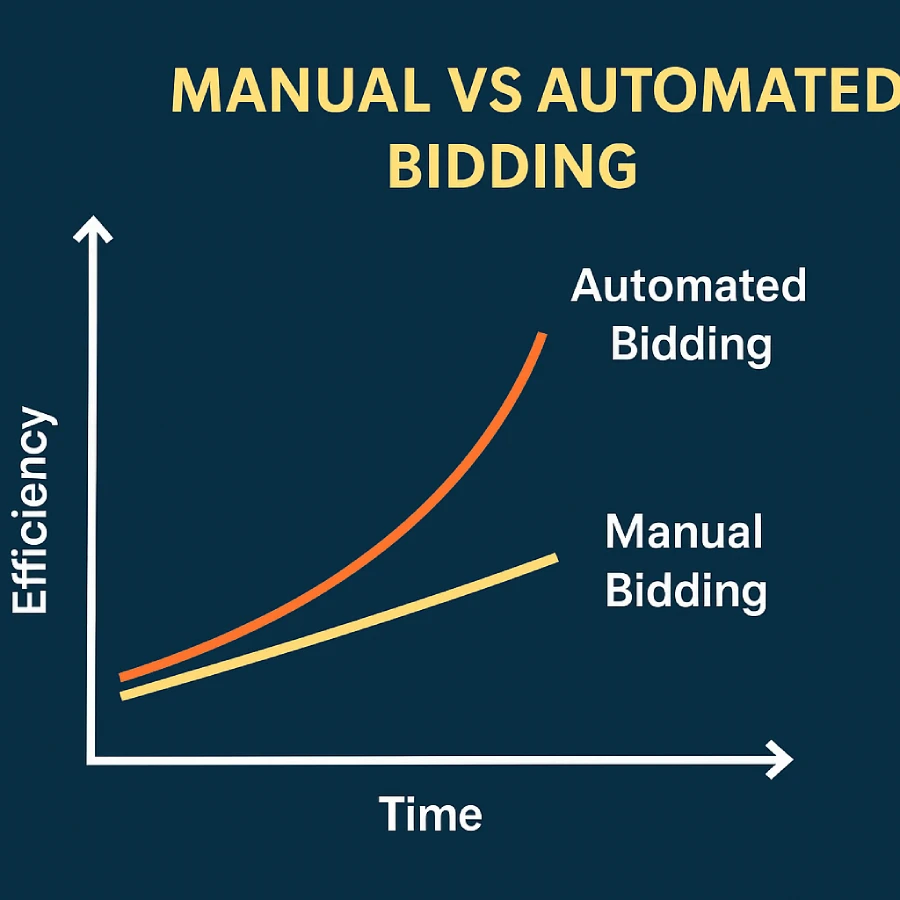When I first started learning Google Ads, I thought manual bidding was the way to go. After all, having full control over how much I bid seemed like the smart choice.
But as I dove deeper, I realized that today’s customer journey is much more complex, and automated bidding can help you stay competitive and efficient.
Question
Why does automating your bid versus using manual bidding contribute to a successful Google Ads campaign?
- The customer journey has become more complex and therefore bids should be based on general user behavior.
- User intent and likelihood to complete valuable actions for your business do not vary based on location, time, or device.
- The appropriate bid can often be a static target that is challenging to reach.
- If you do not bid efficiently, you could miss valuable conversions.
Here is the correct answer:
✅ If you do not bid efficiently, you could miss valuable conversions.
Why is this correct?
1. Complex Customer Journeys
Today’s customers don’t follow a simple path. They switch devices, search at odd hours, and interact across multiple channels.
- Manual bidding struggles to adapt to these fast-changing signals.
- Automated bidding uses machine learning to adjust bids in real time based on who’s most likely to convert.
2. Maximizing Valuable Conversions
Bidding automation optimizes for actions that matter to your business, like purchases or sign-ups, not just clicks.
- Manual bids are static and can’t easily account for things like location, time of day, or device type.
- Automated bidding adjusts dynamically, spending more on valuable prospects and less where conversions are unlikely.
3. Efficiency and Scale
When you automate bids, Google Ads constantly learns and improves your campaign performance.
- This means fewer wasted clicks and a better return on your ad spend (ROAS).
- It frees you from constant manual adjustments, saving time and effort.
4. Risk of Missing Conversions
Without efficient bidding, you risk bidding too low at the right moments — losing valuable customers to competitors.
- Automated bidding helps prevent missed opportunities by increasing bids where conversions are more likely.
Why are the other options incorrect?
1. “The customer journey has become more complex and therefore bids should be based on general user behavior.”
- This sounds reasonable but is actually misleading.
- General user behavior means average trends, ignoring specifics like device, time, and location.
- Effective bidding depends on individual user signals—not averages.
- Automated bidding reacts to specific contexts instantly; manual bids cannot.
2. “User intent and likelihood to complete valuable actions for your business do not vary based on location, time, or device.”
- This is false—intent does vary dramatically.
- For example, someone searching for a product on mobile during lunch hour may have higher intent than someone browsing late at night on desktop.
- Automated bidding models these signals to bid accordingly; manual bids assume uniform intent.
3. “The appropriate bid can often be a static target that is challenging to reach.”
- This statement ignores the power of dynamic bid adjustment.
- Static bids may be too low/high as market conditions fluctuate.
- Automated bidding avoids static targets by continuously learning and adapting to changes in competition and user behavior.
Real-Life Example
A local gym manager was manually adjusting bids but found it time-consuming and inefficient.
They switched to Target CPA automated bidding.
Within 3 months:
- Membership sign-ups increased by 35%
- Cost per acquisition dropped 22%
- Bid management time reduced drastically
The gym reached more ready-to-join prospects without overspending.

Manual vs Automated Bidding
| Feature | Manual Bidding | Automated Bidding |
|---|---|---|
| Bid adjustment by device/time | No | Yes |
| Learns and optimizes over time | No | Yes |
| Saves time on bid management | No | Yes |
| Adjusts bids based on intent | No | Yes |
| Risk of missing conversions | Higher | Lower |
Helpful Resources:
- Google Ads Help: Smart Bidding Overview
- Think with Google: Smart Bidding
- Google Skillshop Smart Bidding Course
- YouTube Tutorial: Automated Bidding
- WordStream Guide: Manual vs Automated Bidding
Conclusion
Automated bidding acts like a smart assistant that adjusts your bids every second, making sure your budget is spent where it counts.
Manual bidding may feel like control, but it struggles to keep pace with today’s dynamic ad environment.
For smarter, more efficient campaigns that capture valuable customers, automated bidding is the way to go.
Now, if you are ready, you can take the Google Skillshop test for the Google Ads Display Exam. Want more real exam questions with easy answers like this? Follow along — I’ll be breaking down more Google Ads Display Measurement Certification Free examples in the next posts!
FAQs
1. What types of automated bidding are available?
Google offers various automated bidding strategies like Target CPA, Maximize Conversions, Enhanced CPC, and others. Each one optimizes bids differently based on your specific advertising goals.
2. Can I switch back to manual bidding after using automated bidding?
Yes, you have the flexibility to switch back to manual bidding at any time. However, be aware that doing so means you’ll lose the benefits of the automation that helps optimize your bids.
3. How long does automated bidding take to learn?
Automated bidding strategies typically require about 1-2 weeks of data to effectively learn and optimize your bids for the best performance.
4. Will automated bidding increase my costs?
Not necessarily. The primary goal of automated bidding is to improve your return on investment (ROI) by optimizing your spend, not simply to increase your overall costs.
5. Is automated bidding good for small budgets?
Yes, automated bidding can be beneficial for campaigns with smaller budgets. However, very tiny budgets might limit the amount of data available for the system to optimize effectively.
6. Can I set bid limits with automated bidding?
Yes, many automated bidding strategies allow you to set maximum CPC (Cost-Per-Click) limits to help control your spending.
7. Does automated bidding work for all campaign types?
Automated bidding generally works best and is most effective for Search, Display, Video, and Shopping campaigns within Google Ads.
8. How do I monitor if automated bidding is working?
To assess the effectiveness of automated bidding, you should track key metrics such as your cost per conversion, conversion volume, and Return on Ad Spend (ROAS).
9. Can automated bidding adjust bids by device and location?
Absolutely. Automated bidding intelligently adjusts bids based on various signals, including device type, geographic location, time of day, and other relevant factors.
10. What if my campaign goal changes?
If your campaign goals evolve, you can easily update your objective within your Google Ads account, and the automated bidding strategy will adapt its optimization accordingly.
